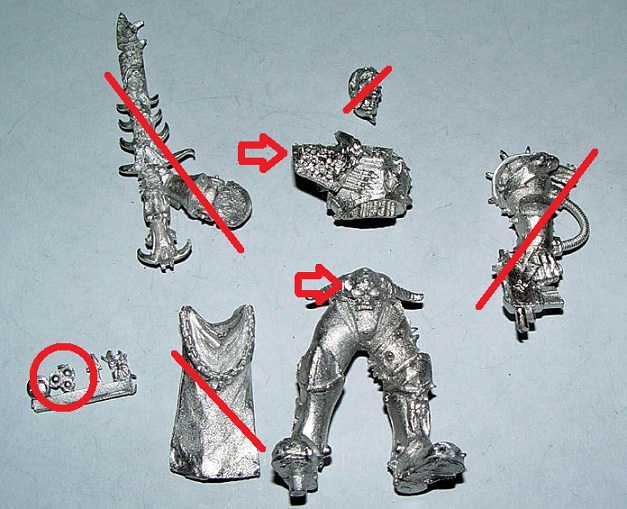One of the things that has always bugged me about the fact that certain Inquisitors could wear Terminator armour was that there were no appropriate minis scaled to show normal humans doing so. Yes, there were (and are) plenty of Terminator minis, but they all depict eight foot tall superhuman killing machines rather than normal humans – if the term “normal” can actually be applied to members of the Imperial Inquisition. During a recent conversation I was challenged to convert one from a standard Space Marine to represent the reduced scale, and it’s quite possible I’ll do that at some point (my so-called friends keep creating challenges that are just barely the right side of insanity for me to consider viable and so I’ve already started thinking about which components will form the basis of it), but on the more immediate front it did make me reconsider an old conversion of mine from a few years ago.
The basis for the conversion was one of my favourite older minis, a figure of a vintage far enough back that it may indeed be from the era of Rogue Trader. I already had the figure made up as a display piece, but it was old enough that it was really showing its age and so it became a donor via a trip through some paint-stripper.
In order to upgrade the look of the piece I grabbed one of the Chaos Terminator arms from my bits-box and cleaned off the unwanted detail and iconography. I simply had to use it – the combination of the power-claw and the wonderfully detailed shoulder-pad was irresistible. I love power-claws. They’re my favourite weapons. If they had them in real-life I’d buy two – one for day-to-day use and one for Sunday-best.
Look closely at the fingers and you’ll see how I’ve curled the middle and smaller fingers in slightly to give a more natural pose. Little tweaks like this can make for the simplest of conversions but still deliver a good-sized visual impact in terms of giving a miniature a touch of life and naturalism.
The main draw-back of using this arm was that it left me with nowhere to put the shoulder pad with the Inquisitorial symbol upon it – you can’t give a figure two left-arms after all. Or can you…
No. You can’t.
What you can do however is remove the left shoulder-pad, reshape the rear so that it fits the right side of the Terminator and then scratch-build an arm and hand for it. And yes, it is a lot of work just to keep a symbol that could just as easily be painted on the finished conversion, but I didn’t get called “Mad Converter” for nothing. You can also see that I’ve used a vehicle-mounted storm-bolter as outlined in Blog 013 – I’m fairly sure this was the first time I did so.
The only other notable addition to the piece was the shrine pinned to the top of the armour. Once again it came from my bits-box so I’m not certain of the provenance, but I’m fairly sure it’s from one of the Black Templar sprues. I chose it because I wanted something that would both identify the Inquisitor on the battlefield and also display the strength of his religious zeal to anyone who faced him. This is a man who is armoured in ceramite and in the armour of faith.
As is common for me the figure was fully based before being broken down into its several pieces and painted in components before final assembly and varnishing. I have to admit that, despite the work I’d done, I didn’t lavish a similar level of effort on the paint-job as it was intended for gaming rather than as a display piece (you may note that the shield is still blank pending the eventual addition of a force insignia).
Although the finished figure isn’t as ornate or impressive as some of the others in my cabinet it still ranks as one of my favourites. It could be the clean lines, the pleasing asymmetry or the martial arrogance of the character, but if I had to admit to a reason why I like him so much I’d have to say that I simply like his overall look – he just seems “right”, if you know what I mean.






















































